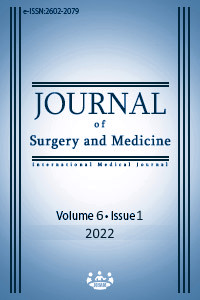Long term outcome in obstetric brachial plexus injury at a tertiary care center
Keywords:
Brachial plexus injury, NARAKAS, Outcome, Children, Birth weightAbstract
Background/Aim: Obstetric brachial plexus injury (OBPI) is caused by traction to the brachial plexus during labor. Traction injury may vary from neurapraxia or axonotmesis to neurotmesis and can cause edema, avulsion, or rupture of the nerve. Improvement in the first two weeks after birth is a good indicator of outcome. The disability varies according to the location and severity of the effect in the plexus. However, most injuries are transient, with a total return of function in many cases. This study aimed to obtain clues for the prevention and follow-up of obstetric brachial plexus injuries by revealing the outcome and clinical features. Methods: In this retrospective cohort study, hospital records of patients with brachial plexus injury due to delivery were reviewed between January 2017 and September 2021. Injury levels, birth weights, other injuries at birth, maternal age, gravidity, gestation time, and treatment response were recorded. Brachial plexus injuries of the patients were classified per the NARAKAS classification. The Spearman correlation and Pearson correlation tests were used for correlation analyses. The variables were evaluated with the Chi-Square and Student's t-tests. The normality of the distribution was assessed with the Kolmogorov-Smirnov test. A value of P<0.05 was considered statistically significant. Results: Thirty-nine cases were included in the study (21 males, 18 females). The mean and median birth weights were 3857 (392) grams, and 3880 (3100-4600) grams, respectively. The median gestational week of birth was 39 weeks. Most mothers were primigravida. All patients were born by vaginal delivery. Per the NARAKAS classification, 29 patients (74.4%) were in group 1, 5 patients (12.8%) were in group 2, 4 patients (10.3%), in group 3, and 1 patient (2.5%) was in group 4. The mean follow-up period was 23.2 (14.1) months. Twenty-four patients recovered spontaneously; six had sequelae without functional impairment, five had sequelae with functional impairment, and two had contractures. The relationship between the NARAKAS groups and birth weight was insignificant (P=0.09). There was a significant correlation between the NARAKAS group and recovery (P<0.001). A correlation was found between sequelae and functional loss (P=0.01) and the NARAKAS group. Functional loss was not related to maternal age, week of birth, birth weight, baby gender (P=0.15, P=0.30, P=0.20, P=0.15 respectively). Conclusion: Permanent functional loss in brachial plexus injury is associated with the NARAKAS classification, and patients in groups 3 and 4 should undergo imaging as soon as possible. Electromyography (EMG), a complex invasive procedure for the newborn, should be preferred if there is no satisfactory recovery. We recommend performing brachial plexus magnetic resonance imaging before EMG to give the patient a chance for early surgery.
Downloads
References
Coroneos CJ, Voineskos SH, Coroneos MK, Alolabi N, Goekjian SR, Willoughby LI, et al. Primary Nerve Repair for Obstetrical Brachial Plexus Injury: A Meta-Analysis. Plast Reconstr Surg. 2015 Oct;136(4):765–79.
Andersen J, Watt J, Olson J, Van Aerde J. Perinatal brachial plexus palsy. Paediatr Child Health. 2006 Feb;11(2):93–100.
Hoeksma AF, ter Steeg AM, Nelissen RGHH, van Ouwerkerk WJR, Lankhorst GJ, de Jong BA. Neurological recovery in obstetric brachial plexus injuries: an historical cohort study. Dev Med Child Neurol. 2004 Feb;46(2):76–83.
Alfonso DT. Causes of neonatal brachial plexus palsy. Bull NYU Hosp Jt Dis. 2011;69(1):11–6.
Piatt JHJ. Birth injuries of the brachial plexus. Clin Perinatol. 2005 Mar;32(1):39–59, v–vi.
O'Berry P, Brown M, Phillips L, Evans SH. Obstetrical Brachial Plexus Palsy. Curr Probl Pediatr Adolesc Health Care. 2017 Jul;47(7):151–5.
NARAKAS AO. The treatment of brachial plexus injuries. Int Orthop. 1985;9(1):29–36.
Yenigül AE, Yenigül NN, Başer E, Özelçi R. A retrospective analysis of risk factors for clavicle fractures in newborns with shoulder dystocia and brachial plexus injury: A single-center experience. Acta Orthop Traumatol Turc. 2020 Nov;54(6):609–13.
Karahanoglu E, Kasapoglu T, Ozdemirci S, Fadıloglu E, Akyol A, Demirdag E, et al. Risk factors for clavicle fracture concurrent with brachial plexus injury. Arch Gynecol Obstet. 2016 Apr;293(4):783–7.
Pondaag W, Malessy MJA, van Dijk JG, Thomeer RTWM. Natural history of obstetric brachial plexus palsy: a systematic review. Dev Med Child Neurol. 2004 Feb;46(2):138–44.
Waters PM. Comparison of the natural history, the outcome of microsurgical repair, and the outcome of operative reconstruction in brachial plexus birth palsy. J Bone Joint Surg Am. 1999 May;81(5):649–59.
Noetzel MJ, Park TS, Robinson S, Kaufman B. Prospective study of recovery following neonatal brachial plexus injury. J Child Neurol. 2001 Jul;16(7):488–92.
Malessy MJA, Pondaag W, Yang LJ-S, Hofstede-Buitenhuis SM, le Cessie S, van Dijk JG. Severe obstetric brachial plexus palsies can be identified at one month of age. PLoS One. 2011;6(10):e26193.
Vredeveld JW, Slooff BC, Blaauw G, Richards R. Validation of an electromyography and nerve conduction study protocol for the analysis of brachial plexus lesions in 184 consecutive patients with traumatic lesions. J Clin Neuromuscul Dis. 2001 Mar;2(3):123–8.
Somashekar D, Yang LJS, Ibrahim M, Parmar HA. High-resolution MRI evaluation of neonatal brachial plexus palsy: A promising alternative to traditional CT myelography. AJNR Am J Neuroradiol. 2014 Jun;35(6):1209–13.
Bauer AS, Shen PY, Nidecker AE, Lee PS, James MA. Neonatal Magnetic Resonance Imaging Without Sedation Correlates With Injury Severity in Brachial Plexus Birth Palsy. J Hand Surg Am. 2017 May;42(5):335–43.
Shen PY, Nidecker AE, Neufeld EA, Lee PS, James MA, Bauer AS. Non-Sedated Rapid Volumetric Proton Density MRI Predicts Neonatal Brachial Plexus Birth Palsy Functional Outcome. J Neuroimaging. 2017 Mar;27(2):248–54.
Downloads
- 766 677
Published
Issue
Section
How to Cite
License
Copyright (c) 2022 Hande Gazeteci Tekin, Özgür Olukman
This work is licensed under a Creative Commons Attribution-NonCommercial-NoDerivatives 4.0 International License.
















